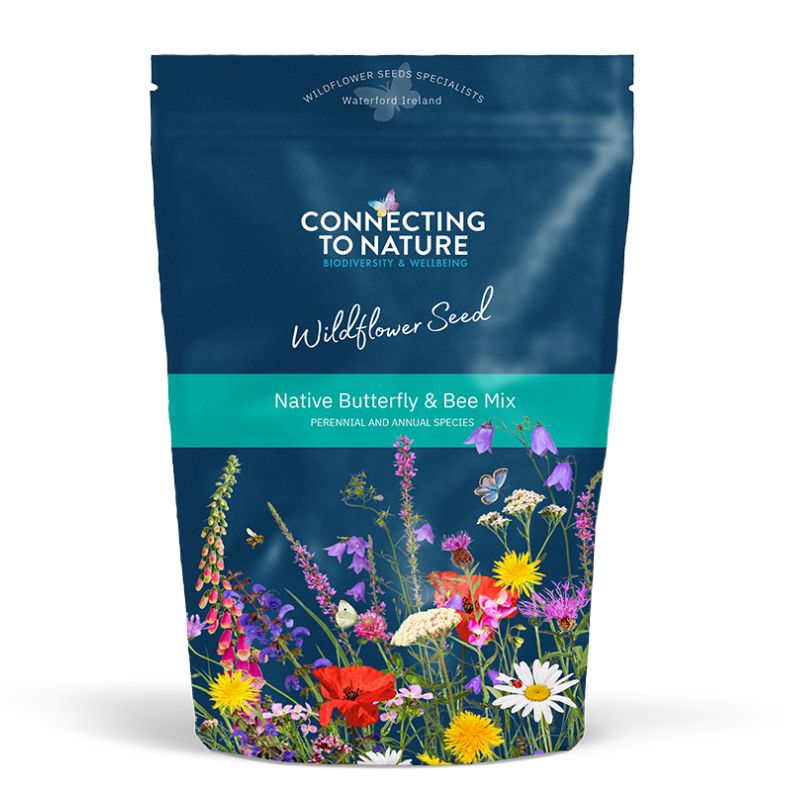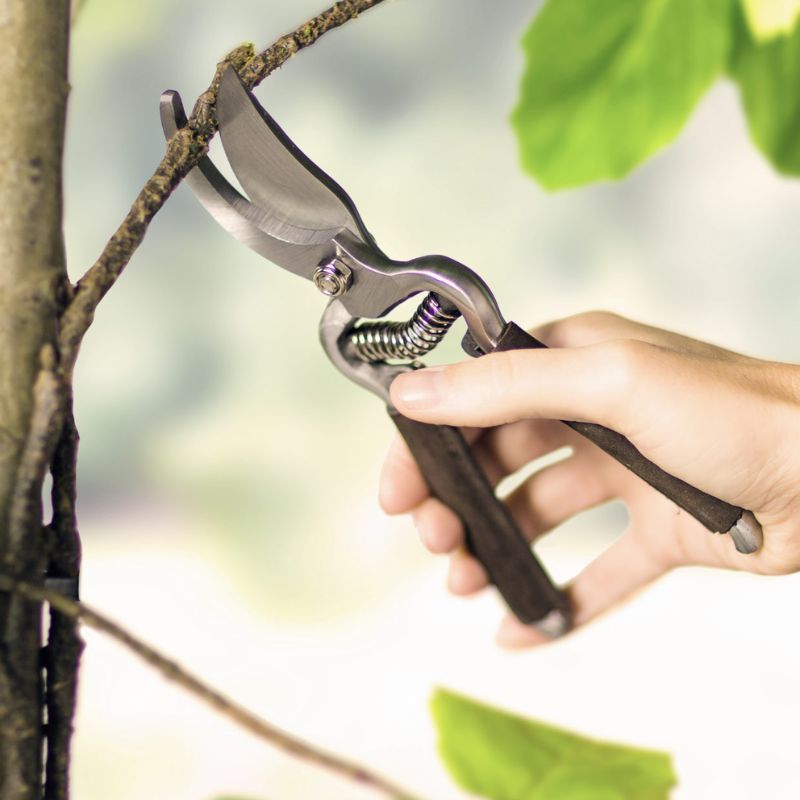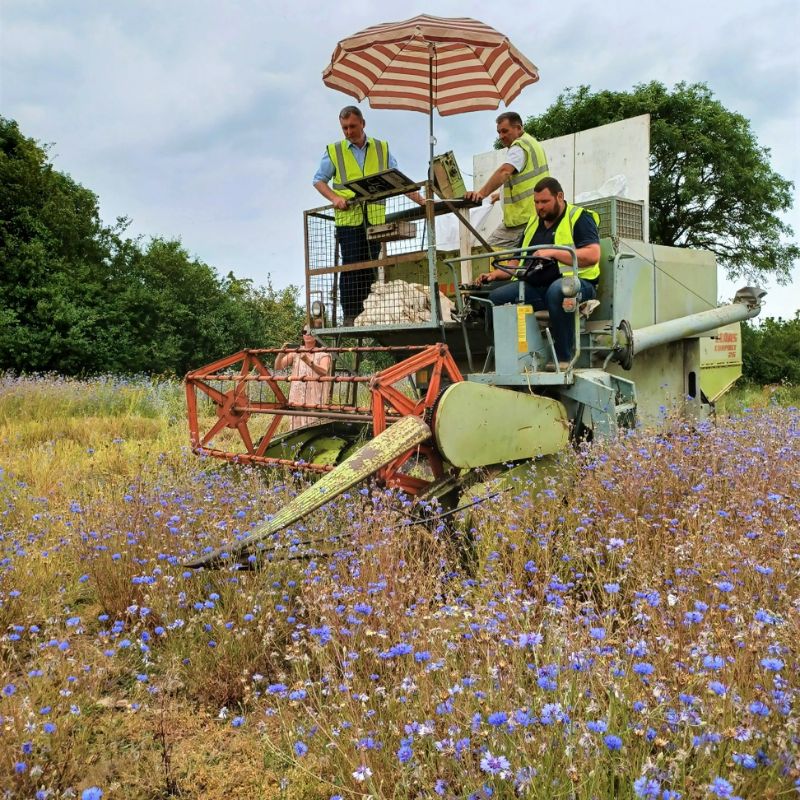Identifying Irish Wild Bird & Their Profiles | Éin Fhiáine na hÉireann
The Blue Tit – Meantán Gorm

The little Blue Tit is one of the most recognisable of all our garden birds. This attractive bird is a colourful mix of yellow breast, bright blue wings and tail, greenish back and a striking white face bordered by a dark blue line.
Blue Tits are common all over Ireland and are found in woodlands, parks, hedgerows and, of course, in our gardens. For much of the year, they are lone survivors. But once the harsher weather sets in and food becomes scarce, they join up in large flocks to search for a new food source. It is not unusual to see groups of 15-20 descending on bird feeders generously laid out in a welcoming garden.
They are very acrobatic and can be found hanging upside-down on even the most difficult feeders if it means that they'll get a bit to eat.
Blue Tits are mainly insect feeders and have a particular fondness for caterpillars. During the winter, when insects are scarce, they will eat seeds and peanuts from feeders. In days gone by, they were notorious for pecking the foil tops off milk bottles to access the cream inside.
They have some of the largest clutches of eggs of all our garden birds. Each clutch can range from 7-13 eggs, and they usually start laying from mid-April onwards.
What foods attract Blue Tits?
During the winter, the Blue Tit will greatly appreciate foods and mixtures containing peanuts, mixed seed and suet. In addition, mealworms and insects are also essential foods during the rearing and fledging stages in the spring.
Our Hi energy No Mess Mix and Robin and Songbird No Mess mix will provide all the nutrition Blue Tits need to survive the Winter and early Spring.
The All Seasons Garden Mix will significantly help during the Spring rearing season.
Did You Know? #DYK
The Yellow on the breast of the Blue Tit is thought to be indicative of the number of caterpillars they have eaten. Some caterpillars contain high levels of the colour pigment carotene, which may increase yellow pigments in the breast feathers.
The Song thrush - Smólach Ceoil

Sometimes, while walking through the garden, you may notice a rustling movement through your flower beds before a flurry of light brown wings explodes from the foliage. This is likely to be the Song Thrush, a shy solitary bird that rarely strays from cover.
This beautiful bird has soft, light brown upper parts and a white chest with black or brown speckles. They are about the size of a Blackbird and are renowned for their birdsong – they may have up to 100 different 'phrases' they use while singing.
Their nests are usually located in deep cover, such as Ivy, and are built relatively close to the ground.
The Song Thrush feeds on insects, invertebrates and fruit and berries but is most well known for its love of snails. Often, you may find a large stone in the garden surrounded by broken snail shells. This is what is known as a thrush 'anvil'. The Thrush picks up the snail in its beak and, with a quick flick of its head, dashes the snail against the stone until the shell breaks. They can then feed on the soft snail inside.
What foods attract the Song Thrush
The Song Thrush will not feed on a hanging feeder and only sometimes from a bird table. To ensure that they are getting fed during the harsh winter days, place some food on the ground for them to use. They will especially appreciate foods containing sunflower hearts, suet and mealworms.
Our Patio and Balcony mix and Robin and Songbird mix are perfect foodstuffs for the Song Thrush.
Did You Know?
In Irish folklore, it was said that the fairies encouraged the Thrush to build close to the ground so that they could enjoy the beautiful music. However, if the nest was built up high in a thorny bush, the fairies were angered, and misfortune was on its way.
The Robin - Spideog

Anyone who likes to garden will know the pleasure of having this little bird as a companion as you go about your chores. One of Ireland's favourite birds, the Robin is instantly recognisable with its red breast and wispy, almost melancholy, song. So popular is the Robin that it has become an unofficial symbol of Christmas and has featured on Christmas cards in Ireland and the UK since the mid-19th Century.
Robins will feed on worms, fruit, seeds and insects. If you have an insect rich habitat in the garden, then the Robin will be happy and well-fed. During the winter, especially during freezing weather, the Robin needs a little extra help from ourselves and will greatly appreciate any food left out.
They are fiercely territorial, however, and in spring it is not unusual to see two males trying to outdo each other by singing loudly and trying to reach a higher perch. If the singing loudly tactic fails to settle the dispute, then a fight will ensue until one is the victor.
The Robin is usually the first bird to begin the dawn chorus and the last to retire for the night.
What foods attract the Robin?
The Robin prefers to feed in a flat, open space and do not visit hanging feeders as much as other birds. However, they will visit hanging or standing bird tables and ground feeders as they prefer a flat platform to land on. A feeder with a roof will be even better as it will prevent food from getting wet.
To attract Robins, put out foods that contain fruit, seeds, and nuts. They also require high protein foods such as mealworms, especially during the rearing and fledging season.
During the winter, our Robin and Songbird Mix is sure to be a hit, while our Fledging and Rearing mix will provide them with the necessary nutrients and protein during the critical hatching and fledging season in spring.
Did you know?
Unlike their European cousins, robins in the UK and Ireland quickly become tame and almost fearless in their willingness to approach humans. This may be down to the part that robins play in Irish and UK folklore. The Robin was seen as a messenger of the spirit world, and it was considered extremely unlucky to harm or kill one.
In Europe, no such tradition existed, and the Robin was hunted for food and sport. As such, the robin populations in Europe never learned to trust humans and their behaviour evolved to avoid humans altogether.
The Wren - Dreolín

The tiny Wren is one of the smallest of our birds but also one of the loudest. Their song can be heard throughout the year, even in the dead of winter. This is a tiny, almost round little bird with long legs and a short, narrow upturned tail.
They are widespread throughout Ireland but can suffer significantly during periods of extreme cold and ice. During cold periods, they band together and can be found clustered together for warmth in birdhouses or small containers. Sometimes many Wrens will be found in these clusters, with the largest congregation found in one garden in the UK, where 61 Wrens were found in an abandoned birdhouse.
The Wren is one of the most widespread birds in Ireland and can be found in most habitats throughout the country. Despite this, they are a secretive little birds and can be very hard to spot – you are more likely to hear one than see one.
They are quick little birds and constantly hunt for insects under bushes, on trees and among fallen leaves. Their tiny size allows them to get into nooks and cranny's that may be off-limits to other birds.
What foods attract the Wren
The Wren feeds almost entirely on insects and grubs and is picky about other foodstuffs. During the winter, they will eat small pieces of fruit or chopped peanuts. They will greatly appreciate bird food containing mealworms or dried insects. Our Robin and Songbird mix includes all three of these ingredients and will provide a source of food in the autumn and winter when Wrens are most at risk.
However, they will rarely visit a feeder and do not like to feed out in the open. Place some food close to the ground near the base of trees and dense shrubs, and you will see them hurry out to get a bite to eat.
Did you know?
Many years ago, at a meeting on the South coast, the birds of Ireland decided that whoever could fly the highest would be declared the King of the Birds.
During the meeting, the Wren hid in the feathers of the Eagle, figuring that it would get the highest. Sure enough, the Eagle soared above all other birds, and when it reached as high as it could go, the Wren flew out of its plumage and flew that bit higher. As the Wren is so small, none of the birds could declare that they had not seen the Wren flying from the ground and grudgingly declared her King of the Birds.
Interestingly a similar story is found in Zulu folklore, but with the Eagle replaced by a Falcon.
The Blackbird – Lon Dubh

The gentle Blackbird is a common but secretive visitor to our gardens. You will often see them hopping along the ground and cocking their head to one side every so often as they look and listen for earthworms. If disturbed, they will run to the nearest cover. Rustling heard beneath a dense hedge or shrub will often turn out to be a blackbird rummaging through leaf litter and the undergrowth in a quest for worms and insects.
The Blackbird is one of the easiest birds to identify in the garden. The males have a deep black plumage contrasted with a bright yellow beak and a distinctive yellow circle around each eye. Females are chocolate brown with a lighter, faintly mottled breast and a dark brown beak.
The song of the Blackbird is a slow, melodic, at times almost mournful, tune with a wide range of notes and one which carries far in the wind. The song rarely repeats, with notes constantly changing in subtle ways. The song can be heard from the beginning of the year until the early days of autumn.
What foods attract the Blackbird
Blackbirds feed on a variety of foodstuffs but mainly look for insects and worms. They will also eat berries and other fruit in the autumn.
They will not feed on a feeder but will visit hanging bird tables and ground feeders. The best foods to leave out for them are seeds and fruit pieces. Birdfeed containing these foodstuffs, along with Mealworms and suet pieces, will be greatly appreciated.
Did you know?
The blackbird features in a short poem scribbled in the margins of a 9th Century ecclesiastical text for Bangor Abbey. The poem is called 'The Blackbird of Belfast Lough'. There have been many translations of this poem, but the most famous is the Seamus Heaney translation.
The small bird chirp-chirruped,
yellow neb, a note-spurt.
Blackbird over Lagan water.
Clumps of yellow whin-burst!
Seamus Heaney
The Goldfinch – Lasair Choille

The Goldfinch is a spectacular looking garden bird and has been admired for its colouring for centuries. In fact, it was so admired that its numbers were drastically reduced in the 1800s due to trapping by collectors. Thankfully, laws introduced in the 20th Century outlawing the trapping of wild birds have helped the Goldfinch numbers to rebound.
Goldfinch colouring is very distinctive with a red face, white head, and black markings around the eyes (it looks almost like the mask Zorro wears in old adventure movies). A large yellow bar is found on the wings, with black markings and white spots down the tail. The back of the Goldfinch is a light chestnut brown colour.
The Goldfinch is a seed eater, as determined by the short, stout, and powerful beak that is perfect for breaking shells. They will search out seeds wherever they can find them, from thistles and trees to grasses and dandelions. They are the only bird able to secure the usually inaccessible seed from the Teasel plant.
They are sociable birds and tend to flock together in large numbers, with some Autumn flocks numbering in the thousands. A flock of Goldfinches is known as a 'charm'.
What to foods attract the Goldfinch?
Goldfinches are seed eaters. They will feed on garden plants such as Teasel, Echinops, Thistle and Rudbeckias during the winter. If you have these plants growing in your garden, leave them standing for the winter rather than clearing them away in autumn.
Goldfinches will readily use hanging bird feeders and are especially attracted to foods that contain tiny seeds, sunflower seeds and peanuts.
Our All Seasons Garden Mix and Hi Energy No Mess Mix is particularly suitable during the winter months.
In spring, the Rearing and Fledgling mix will be massively appreciated.
Did you know?
Goldfinches are particularly attracted to seeds from the Thistle family of plants. So much so that their Latin name, Carduelis carduelis, is derived from the word Carduus, which is Latin for Thistle.
The Coal Tit – Meantán Dubh

The Coal Tit is a widespread bird in Ireland. Originally a woodland bird, it can now be found in most gardens in the country, especially those in areas with many trees.
They are a small bird, one of our smallest, and can reach a length of just 4 inches when fully grown. They have a black, almost hooded appearance to their head that is emphasised by distinctive white cheeks and a white patch on the nape of the neck. The back feathers are dark with white wing bars, and the underside is a pale grey.
The Coal Tit is a very acrobatic bird and can often be seen hanging upside down from branches as it hunts for food in trees. They are mainly seed eaters but will also eat grubs, spiders and other insects. They are particularly fond of seed from conifer trees.
They have a habit of hoarding food, taking it from bird tables and secreting it in nooks and crannies around their territory.
What foods attract the Coal Tit eat?
The Coal Tit is a seed eater and has a distinct fondness for peanuts. They will take and hide any seed they can easily get hold of and clean out a bird table in short order. This is why it is essential to use a hanging Wire feeder when feeding them – otherwise, you will be restocking with food many times a week.
Our Hi Energy No Mess mix and the Patio and Balcony No Mess mix contains the ingredients necessary to attract and satisfy these wonderful little birds.
Did you know?
There are eight sub-species of Coal Tit, including one exclusive to Ireland called Periparus ater hibernicus. This species can be distinguished from the rest by a yellow tinge to the white cheek and neck patches.
The House Sparrow – Gealbhan Binne

The House Sparrow is one of the most widespread bird species in the world. In Ireland alone, it is estimated that there are over 1 million breeding pairs in the country. As the name suggests, the House Sparrow is closely associated with humans and our homes. They will make their homes in small cavities and holes in buildings and walls and sometimes nest in groups in dense hedgerows or garden hedges.
The House Sparrow is a small bird not much larger than a Robin. They have a rich light brown plumage on their backs and a dark smokey cap on their heads. Their breast is a light grey with a distinctive black, speckled 'Bib' on the neck.
House Sparrows will often form large flocks and can be seen in late Summer and Autumn swooping over and landing in freshly cut grain fields feeding on fallen grains. Those who garden may also have encountered large numbers destroying their vegetable beds during dry periods.
This is because the House Sparrow likes to 'bath' in the light dry dust. It is thought that this behaviour helps to remove lice and dry skin from the feathers and keep the plumage in good condition. You will see them rolling around and creating a bowl-shaped hollow to sit in, right in the middle of your prized lettuce patch.
However, numbers have decreased in recent years, possibly due to fewer nesting spots in new buildings and improved hygiene and storage measures in grain stores and warehouses. In the UK, numbers have decreased by up to 60% since the 1970s.
What foods attract the House Sparrow?
House Sparrows are seed-eating birds and search for seeds, grains, berries, and insects for the nestlings. Therefore, it is not difficult to attract them to a hanging feeder or bird table. They have a particular fondness for peanuts, sunflower seeds and millet. However, they will accept any food if they need it. They search out high protein insects during the spring and take mealworms if they find them.
Our All Seasons Garden Mix and Hi Energy No Mess mix will be perfect for them. During hatching season, the Rearing and Fledgling mix will be a massive hit.
Did You Know?
House Sparrows like to nest close to humans in cavities in houses and walls. However, they have been found in more unusual locations. For example, a small flock was seen living entirely indoors at Terminal 2 in Heathrow Airport. They spent most of their time close to the snack bar feeding on crumbs. Another breeding pair resided for two years in a Yorkshire coal mine nearly 2000 ft below ground!
The Starling – Druid

The Starling is a glossy black bird often mistaken for an actual Blackbird.
Look closer, though, and you will find that their plumage is a lot more decorative than it first appears. If you catch it in the proper sunlight, you will see that their plumage is tinged with shimmering greens, purples and blues. In winter, adults become speckled in yellow and white spots, and the beaks change colour from a bright yellow to a dark brown.
Starlings are a social bird, and flocks of up to 100000 can be found performing elaborate displays over water and fields. These gatherings of Starlings are known as a Murmuration.
Starlings have evolved to feed in flocks as this provides additional protection against predators. These flocks may expand to include up to half a million individuals during winter when European migrants join with our resident birds to escape severe continental winters.
Starlings are also excellent mimics and can imitate the call of other birds, as well as car alarms, phones, and whistles. Some have even learned to mimic animals like cats, dogs and sheep!
What do Starlings eat?
The Starling is an insect eater in the main, as seen by its long, pointed beak. They will push their beak into long foliage and open their mouth wide, catching insects that fall as they move about. But they are an opportunistic feeder and will accept almost anything they can get their beaks on.
Often, they can be enthusiastic about finding food and will clear a feeder in a very short time, depriving other birds of an opportunity to feed.
A Caged Feeder or Caged Fat Ball Holder can be used to prevent them from stealing food from other birds.
Did You Know?
Classical composer Mozart was fascinated with Starlings and their ability to mimic sounds. So in 1784, he purchased a Starling and taught it the opening lines to his 'Piano Concerto no. 17 in G Major' (another story claims that he initially learned the melody from the bird).
When the bird died a few years later, he threw a formal funeral ceremony complete with mourners, singers, hymns, a tombstone, and a funeral procession.
The Greenfinch – Glásan Darach

The Greenfinch is a stocky little bird that was traditionally found in fields and farmland rather than gardens. However, since the 1950s, it has become more and more common in towns and suburban gardens.
Greenfinches have a large head with a tough, cone-shaped beak and a short, stubby tail. The plumage is a mix of green and grey feathers with vibrant splashes of yellow at the tips. The strong beak is perfect for breaking open a wide variety of seeds. During the autumn and Winter, the seeds of Hawthorn, Yew and Brambles are an essential part of their diet.
They are sociable birds, often choosing to feed in groups at a feeder or bird table. However, these feeding sessions can get quite entertaining as individual Starlings squabble over food. These arguments can get quite heated with wings spread, and beaks open in a threatening manner.
Occasionally this will result in physical contact as two Greenfinches launch themselves into the air at each other with a fast flapping of wings before they settle down again. Greenfinches will often nest in groups of four pairs and prefer the sanctuary of dense evergreen hedges.
What foods attract the Greenfinch?
The Greenfinch is a seed-eating bird and will flock to any feeder which contains a mixture of different seeds. They are pretty partial to sunflower hearts and peanuts. During the rearing season, they prefer to feed nestlings with insects as they are high in protein. Mealworms are especially important during these periods.
Our Rearing and fledgling mix will provide all the nutrients and seeds that the Greenfinch could want during the Spring nesting and rearing season.
For all year round feeding, try our All Seasons Garden mix, while our Patio and Balcony No Mess Mix and Hi Energy No Mess mix contains the always popular peanuts, along with striped and peeled sunflower seeds.
Did You Know?
During the harsh Winter of 1890-1891, newspapers in the UK and Ireland advised their readers to leave food for the birds to help them survive. This became a hobby for many people to such an extent that in 1910 the Punch magazine declared bird feeding a 'National pastime'.
As a result, more than a Century later, Greenfinches in mainland Europe rarely visit gardens, while in the UK and Ireland, they have become a familiar and common garden bird.













